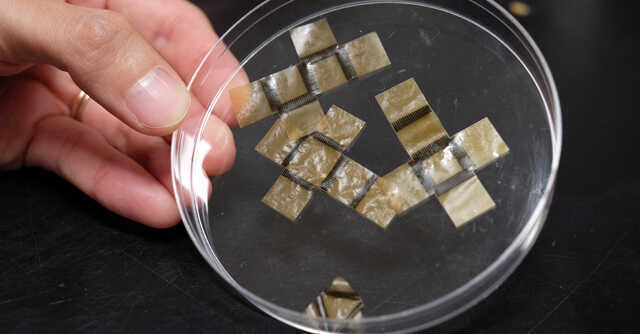
Scientists develop self-folding paper that can be used as ‘intelligent’ green products


Scientists at Nanyang Technological University (NTU) in Singapore have developed a paper-like material from sunflower pollen that on contact with moisture in the air can fold and bend to take up 3D shapes based on patterns laser printed on it.
The research paper on this was published today in Proceedings of the National Academy of Sciences of the United States of America (PNAS), a leading peer-reviewed scientific journal.
According to the NTU research team, the material’s ability to fold and bend makes it usable as intelligent green products such as self-folding envelopes, boxes, and food containers.

The scientists believe the material can also be used as origami robots in electronic and biomedical applications to fulfill specific shape requirements such as shape-dependent tissue engineering and stimuli-triggered drug delivery.
The material is made of two layers. The first layer includes a soft microgel developed from sunflower pollen grains using a process similar to soapmaking.
The second layer is made of styrene acrylate copolymer, which is water repellant and is found in laser toners and other edible inks. Though commercial laser printers were used for the study, as per the research team, standard digital printers with edible inks would also work.

Subra Suresh, Professor at NTU University, said in a statement that for this research the scientists went back to previous studies on the unique properties of pollen.
“We combined easy-to-process pollen grains and cost-effective digital printing to develop a moisture-sensitive biomaterial-based system that can morph on demand into geometrical configurations that lead to complex shapes depending on the patterns we print,” he added.
Suresh was the senior corresponding author for the research, which included several other senior scientists from different departments at NTU.

The NTU team also used computational simulations to model and predict changes in shape based on the printed pattern in response to various levels of humidity.
Suresh points out, “This helped us to develop a general framework for materials and geometry design to produce highly controllable shape-morphing natural materials in a scalable and sustainable manner.”
Though the folding process is reversible, the 3D shape taken on by the material can be made permanent by freezing it with a layer of chitosan, a natural sugar found in shellfish, the scientists said.

In a video, the scientists demonstrated how the pollen material folds and bends according to the angle of the lines printed on it. For instance, if the pollen-based material had stripes printed at a 60° slant it would coil up to form a straw. The material was tested with several geometrical configurations including straws, boxes, and 3D paper orchids.
The NTU research team has applied for a commercial patent for the technology.
